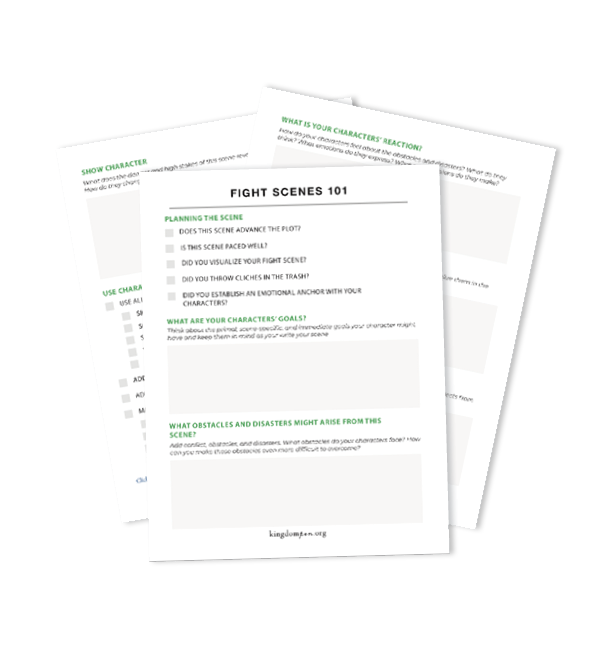By Mark Kamibaya
More often than we would like, we read fight scenes. And more often than we would like, we read boring fight scenes. Fight scenes that don’t keep us on the edge of our seat, but make us flip pages to see when it ends.
So how can we make gripping fight scenes that engage and enthuse our audience? It takes both careful planning and considerate writing.
Planning the Scene
A fight scene is a fight scene. Therefore, you should plan it in the same way you plan all your other scenes. So approach it using these five simple scene planning principles.
If you want to follow along with this article, be sure to get the free workbook!
1. Every Scene Needs to Advance the Plot
This isn’t easy. It’s hard to cut scenes you’ve worked hard on. Some scenes are there just to show your great writing skills. Cut them.
Some scenes don’t exactly advance the plot, but give great characterization moments (like showing a protagonist has awesome fighting skills). Cut it.
Worst case scenario is the reader will put down your book because she’s always losing the plot. Any scene that doesn’t advance the plot needs to be cut.
2. Pace Your Scenes
Two big secret reveals in a row? Hinges on melodrama. Two character deaths in a row? Too much angst. Two major fight scenes in a row? Boring.
This applies to fight scenes even more because some authors (usually guys) love action so much they just stick it in at every opportunity for any excuse. “Well, I’ll put a fight scene in here because it will show that Bobby likes kittens so much he literally fights for their rights!” (Also a great characterization moment) Please, no.
3. Follow Basic Scene Structure
This is where many fight scenes go wrong. It’s a fight scene. Follow basic scene structure. Goal, obstacle, reaction, new goal.
Most authors go wrong when they forget reaction. They have such high-octane action scenes that they forget to make their protagonist react. Even the most battle-hardened soldier has at least some reaction whether it is a tinge of horror or a pound of perseverance. The reaction is important for your protagonist’s new goal (which leads directly into the next scene).
4. Visualize
“But I’m writing a book not a movie!” You’re right. But don’t you want to the audience to see everything play out in their mind’s eye? How can you expect the reader to imagine what you can’t imagine yourself?
Begin with placement. How far are the characters from each other? Could they be close enough for the protagonist to knock the gun out of the antagonist’s hand? Where is everything in relation to the characters? How far does that gun fly out of the antagonist’s hand?
Then the movements. Be a fight coordinator and tell your characters what to do and how to move. After that move onto the details. Tone of voice. Lighting. Body language. Remember: if you can’t see it yourself then neither can the audience.
5. Throw Cliches into the Trash
Infuse your scenes with fresh situations. Everybody should keep this in mind while writing any story.
Examples of clichés are the everybody-shoots-at-the-antagonist-then-the-smoke-clears-and-he’s-still-standing. Or the protagonist-is-on-the-ground-groping-for-his-weapon (the antagonist may or may not step on the weapon). And especially the protagonist-beats-up-multiple-people-and-walks-off-unwounded.
So think up original ideas not only in your fight scenes, but in every scene. Flip clichés. Whip out unprecedented innovations.
Planning for Character
So you have a fight scene. But what about the fight scene. Well, I’m sorry to tell you this, but there is no fight scene. Now before you stomp away, let me tell you why this is. A fight scene is a type of scene. That’s why you need to plan it not like a fight scene, but as a fight scene. So what about the fight? Look at the third sentence of this paragraph.
The idea behind this certain methodology is focus. If you always focus on what kind of scene it is then you will forget what it really is. Like thinking of a chocolate cake as chocolate, but not cake.
So you’re planning a scene which is a small section of the . . . plot. And plot plus what equals story? Character. You need to plan for character. “How do I do that?” Glad you asked.
1. Make Sure the Readers Already Have an Emotional Anchor with Your Characters
Why’s this? Simply because the more the readers care about your characters, the more they are pulled into the story.
In the action-driven culture that we have today, you could care less for the hero facing death. It’s when you have formed a friendship bond with the character that you feel fear for him as he faces danger.
2. Plan with the Characters’ Goals in Mind
All of them. But just some of them. “What?” Okay, what I mean is there are three types of goals that you need to remember for the character. Primal, scene-specific, and immediate.
Primal is where most authors mess up. It’s the goal that is basic. It’s the character’s driving force and is super easy to understand. Survival, fear, love, hunger, protection (of yourself or others). This goal overarches the whole story.
Scene-specific is where I confused you. This is the goal for (obviously) that specific scene. In a fight scene it’s probably beat up this guy.
Immediate is pretty simple. In a fight scene it can be get out of the way of that fist.
Bottom line: keep all of these character goals for each character in mind as you write your scene (especially the primal goal).
Note on the character goals: All human beings are driven towards God. However, this is too broad (even too primal) to be a primal character goal. It’s too primal in the same way that all human beings have a primal goal to eat or survive (which is why we eat). Also you may think I missed the story goal, which is what the character wants to accomplish in the long run (or simply the goal for the story). However, the story goal is actually just an embodiment of the primal goal.
3. Use Uniqueness
Every character is unique just like a real person. They all have unique abilities. Use those abilities.
Have a character that’s really good with tying knots? Have him tie a series of knots to trap the enemy. Have a character that does magic tricks? Have her pull out a knife out of thin air.
You can also use the uniqueness of the actual character. Have a character scared of fire? Have her fight in a burning building or (in fantasy) an enemy who can control fire. Have a character with a bionic arm? Have him tweak the arm to give him superhuman strength or make it malfunction at a key point.
Uniqueness can extend beyond character into the realm of setting. Make your protagonist use the setting while fighting. A frying pan to bash with. Hot coffee to distract. A tree to climb. A wall to run on (trust me, it’s possible). Give your characters places and things to use in the fight. Your audience will enjoy the unique twist you gave a boring fight scene.
4. Show Character
This is easy to forget. We see the fight we forget the people in it. The more you are with someone the more you get to know them. But you really get to know them in the thick not the thin. Danger more than anything shows true character. People can become scarred for life with just one encounter. People change when they go through a crucible.
Fights are more than just bashings. They are experiences. Use them to show your audience who your characters truly are.
To be continued in part two: Fight Scenes 101: Writing The Fight
If you enjoyed this article, be sure to download the free workbook that goes with this lesson. This will help you implement everything you learned today and give you everything you need to create great fight scenes.
Mark Kamibaya
Mark Kamibaya is a sixteen-year-old missionary kid from the Philippines. And a self-proclaimed weirdo. He has been in private school and taken some college classes, but has been homeschooled for most of his life. He has always had a great love for stories and started writing at the age of twelve. He mainly writes realistic science fiction and can’t hold all the concepts spilling out of his brain. Mark hopes to one day become either an author or a counselor. Preferably both. Besides, writing he enjoys soundtracks, exercising, movies, and systematic theology. That’s in reverse order.



Great article, Mark.
Thanks!
[…] all been there. We’re immersed in a fantastic action sequence, our hearts pounding with adrenaline. We fear for our favorite characters’ lives and […]
Awesome!